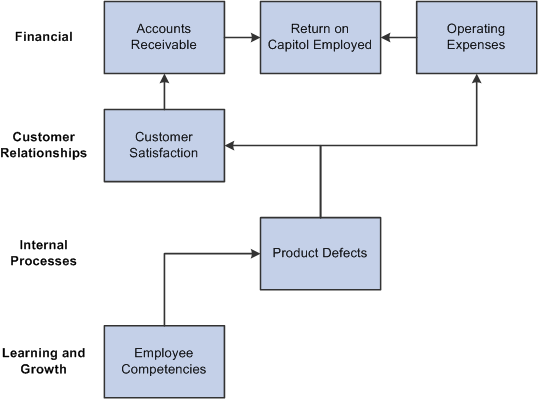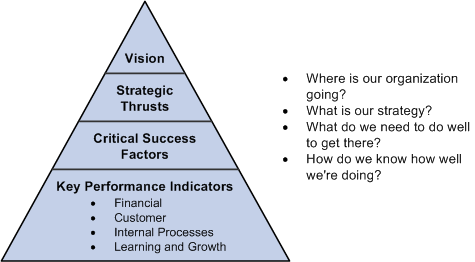Balanced Scorecard Theory
This topic contains an overview of balanced scorecard theory. While the Scorecard application was based on this theory, its design is flexible enough not to be limited by it. For a detailed discussion of the balanced scorecard theory, including examples and case studies, please refer to the book The Balanced Scorecard by Robert S. Kaplan and David P. Norton.
The balanced scorecard concept arose out of a recognized need to measure success on more than just financial statements. Focusing strictly on financial results doesn't provide an organization with the information that it needs to prosper in today's environment. Financial results provide an indication of past performance, but don't provide you with insight into your current status or where you'll likely be in the future. In addition, the balanced scorecard provides a framework and language that enable you to describe your strategy in a consistent, reliable manner.
The ultimate goal behind balanced scorecard theory is to measure the factors that create value for an organization and directly influence its ability to prosper. To do that, you must determine the answer to these questions:
Where is the organization going?
What is our strategy?
What do we need to do well to achieve our strategy?
Measuring Across a Range of Indicators
With a true balanced scorecard, strategy and corresponding measurements are balanced across four areas: financial, customer, internal, and learning.
The Scorecard application enables you to define your own perspectives.
See (Optional) Establishing Additional Perspectives.
Each business determines its own performance indicators. A bank might look at customer-to-account ratios, for instance, while a hospital might consider numbers of doctor referrals and patient satisfaction surveys. The data can come from back-office applications such as enterprise resource planning (ERP) systems, datamining and customer analytics software, or competitive reports and industry averages.
Balancing Measures
In addition to balancing your strategy, the objects that you use to measure your success should be balanced, and you should take into consideration:
Performance drivers (leading indicators) and outcomes (lagging indicators).
An effective balanced scorecard needs a combination of both performance drivers and outcome measures. Without outcome measures such as profitability, market share, or customer satisfaction, among others, a scorecard does not provide an indication of how well the organization is performing. Without performance drivers, such as objectives that are categorized within the internal and learning perspectives, you don't have an indication of whether your strategy is working. Performance drivers also communicate what steps are required to achieve the strategy.
Internal and external indicators.
Try to balance measures across indicators internal to your organization, such as sales growth rate, as well as those that are external, such as stock price or customer satisfaction rating.
Qualitative and quantitative measures.
Try to include measures that provide both qualitative information, such as employee satisfaction level, and quantitative information, such as sales amount.
Linking Objectives and Measures
Objectives and measures need to be linked through cause and effect relationships. Causal paths from all the measures on a scorecard should ultimately link to financial objectives. This not only indicates how each measure impacts the financial goals, but it also illustrates to all members of the organization what impact their actions have on the outcome of the overall strategy.
The following diagram shows an example of how objectives and measures link with cause and effect relationships:
Image: Cause and effect example
Cause and effect example

Applying Balanced Scorecard Theory
We've aligned our application with the balanced scorecard theory established by Robert S. Kaplan and David P. Norton so that you can fully benefit from the knowledge upon which it is based. The Scorecard application provides you with the tools that you need to translate your strategy into a scorecard, communicate it throughout your organization, measure progress towards achieving defined goals, inform key individuals automatically about scorecard status, and determine why problems occur. The following diagram depicts the hierarchy of Scorecard elements from Vision at the highest level, then strategic thrusts, then critical success factors, then KPIs at the lowest level, and how they associate with your organization's strategic goals:
Image: Measuring factors that create value for an organization
Measuring factors that create value for an organization
